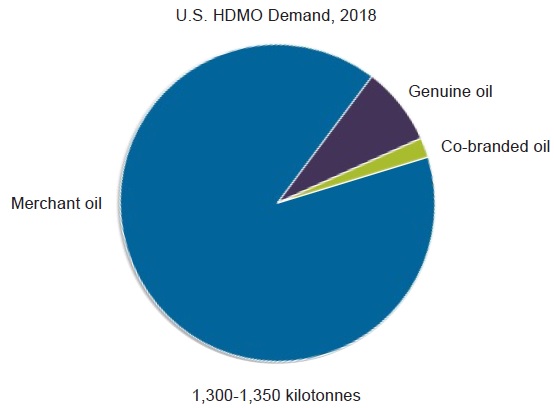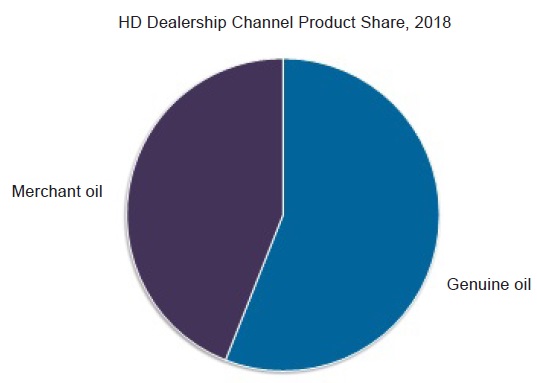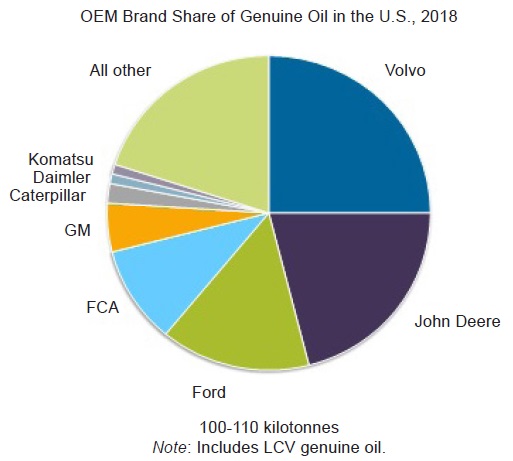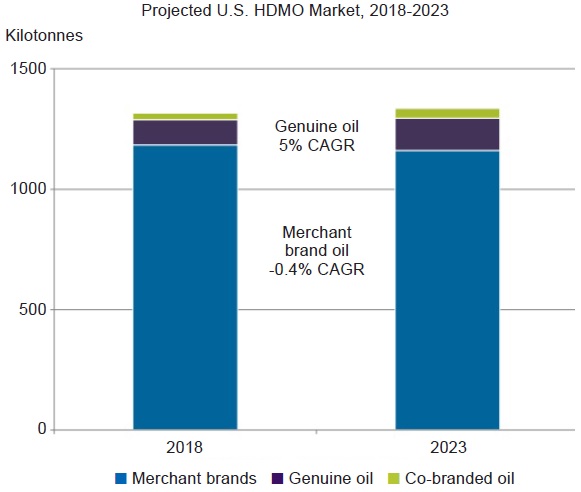The heavy-duty motor oil (HDMO) market is projected to grow steadily and slowly over the next few years as the commercial vehicle market continues to expand. OEM genuine oil use in this market is still relatively minor and in the U.S. accounts for around 8% market share. While some off-highway OEMs such as John Deere have had a genuine oil for quite some time, others have only recently begun to introduce their own genuine oils or have begun promoting genuine oil use. The increasing availability of genuine oils, OEMs looking to promote genuine oil and parts (fleet expansion and replacement of older vehicles) is projected to help grow the genuine oil share at nearly 5% (compound annual growth rate) in the U.S. (
see Figure 1).
 Figure 1. Genuine oil share is projected to grow at nearly 5% in the U.S. in the next few years.
The genuine oils market
Figure 1. Genuine oil share is projected to grow at nearly 5% in the U.S. in the next few years.
The genuine oils market
OEM genuine oils are lubricants that lubricant blenders manufacture per the specifications of the OEM and are sold with a brand name or a trademarked name exclusive to the OEM. However, the blender may be occasionally identified on the back label with the OEM’s label on the front of the packaging. OEM genuine oils are usually sold through OEM-authorized dealerships or service centers, which account for roughly 10% of the overall HDMO sales. There also has been some growth in retail and online sales of genuine oils recently (
see Figure 2).
 Figure 2. Growth in retail and online sales are among the reasons why the genuine oils market is expanding.
Why OEMs offer genuine oils
Figure 2. Growth in retail and online sales are among the reasons why the genuine oils market is expanding.
Why OEMs offer genuine oils
Though motivations vary by OEMs, there are three key reasons for OEMs to market genuine oils:
1.
Customer retention and brand building
2.
Better protection of their engines
3.
Creating an additional revenue stream.
OEMs not only build and sell commercial trucks and vehicles, they must maintain a service and parts distribution network for after-sales service and maintenance of their vehicles. For customers, total cost of ownership can be a major factor in vehicle selection. OEMs that can provide quality and speed of after-sales service of their vehicles provide their customers with maximum uptime for their equipment and help build brand loyalty. Nearly every OEM promotes the premium quality of genuine oil and parts to help reduce the overall cost of ownership and provide the maximum return on investment.
Many OEMs set more stringent engine oil performance specifications beyond industry service categories such as those set by API and The European Automobile Manufacturers’ Association. These specifications were designed by OEMs for the best protection for their latest engine technology and to help themselves extract the most performance, efficiency and fuel economy out of their vehicles. In addition, with increasingly stringent emissions regulations, OEMs need to protect their exhaust after-treatment devices, which tend to vary from OEM to OEM. The OEMs are ultimately responsible for the warranty of their new vehicles and will update their engine oil performance specification as they develop new technology, often working with lubricant suppliers to co-develop a better engine oil. The genuine oil will meet the latest specifications while the broader merchant-branded oil market might take a little time to update to newer specifications.
OEMs also view genuine oil and spare parts as another source of revenue and growth for their businesses. Growth in vehicle sales is often dependent upon the economy and government policies where after-market service/parts is slightly more stable and depends more on the vehicle fleet sizes than utilization rates (
see Figure 3).
 Figure 3. OEMs view genuine oil and spare parts as a source of revenue and growth for their businesses.
Figure 3. OEMs view genuine oil and spare parts as a source of revenue and growth for their businesses.
How customers view genuine oils
For customers, the selection of genuine oil and parts depends on their perception of the OEM brand, the locations of the authorized service centers and the difference in service quality compared to local independent workshops.
Consumers’ perception of a brand is usually based on their experiences and personal choices. OEMs can be classified as premium OEMs or as value OEMs, and their parts and genuine oil are likely to be viewed in a similar fashion. Customers are likely to view premium OEM-branded oils of higher quality over merchant-branded oils; in contrast, genuine oils offered by lesser-known OEMs are likely to be viewed as lower quality compared to merchant-branded oils unless they co-brand with a major merchant brand.
Dealerships and authorized workshops for commercial vehicles are more geographically dispersed compared to the passenger car market and, while OEMs are selective in locating their dealerships/workshops near major markets and highways, there are frequently only a few locations per region to choose from. This can make access to genuine oil difficult as the main channel is through authorized workshops and dealers.
For the customer or business, the commercial vehicle is viewed as equipment utilized to conduct business and generate profit. As such, initial cost as well as total cost of ownership and overall uptime are factored into vehicle selection. OEMs often focus on the quality of service for their vehicles and use that quality of service at their workshops to help customers reduce their cost of ownership and maximize equipment uptime.
Genuine oil outlook
The commercial vehicle industry has been growing, fueled by increasing demand for trucks and equipment in developing nations as well as demand for transport trucks in mature markets where e-commerce continues to take off. Replacement vehicles also are driving new-equipment demand as nations become more stringent on emissions both in on-road and off-road applications.
The HDMO market is projected to grow with the growth in commercial vehicle sales and has largely been led by major merchant brands from the multinational lubricant suppliers. The HDMO market has only recently begun to see the growth in OEM genuine oil; large commercial OEMs have had genuine oils for a few years while some medium-sized OEMs have just begun to introduce their genuine oils.
Commercial vehicle OEMs are implementing genuine oil programs for many of the same reasons as consumer vehicle OEMs, though implementation strategies will differ as the dealership and workshop networks differ greatly from the consumer side. Commercial OEMs will offer more extended warranties as well as service and maintenance packages to their customers. These extended service/warranty packages will be increasingly popular as new equipment becomes much more complex with emissions compliant exhaust after treatment devices and telematics/automation to help businesses optimize equipment uptime and optimal utilization. This in turn will drive more vehicles back to authorized workshops, which are mainly the exclusive channel for genuine oil, making this a growth market worth monitoring while merchant-branded volumes are projected to contract slightly (
see Figure 4).
 Figure 4. Genuine oil growth will outpace the merchant brand oil market.
David Tsui is a Project Manager at Kline & Co. in the Energy practice. You can reach him at david.tsui@klinegroup.com
Figure 4. Genuine oil growth will outpace the merchant brand oil market.
David Tsui is a Project Manager at Kline & Co. in the Energy practice. You can reach him at david.tsui@klinegroup.com.
Kline is an international provider of world-class consulting services and high-quality market intelligence for industries that include lubricants and chemicals. Learn more at www.klinegroup.com.